CHCDIV002: Promoting Aboriginal and Torres Strait Islander Health
VerifiedAdded on 2022/10/12
|7
|1495
|1
Report
AI Summary
This report addresses the health disadvantages faced by Aboriginal and Torres Strait Islander peoples in Australia, stemming from historical and ongoing social, financial, and cultural factors. It examines the need for government accountability, negotiation and consultation procedures to ensure cul...
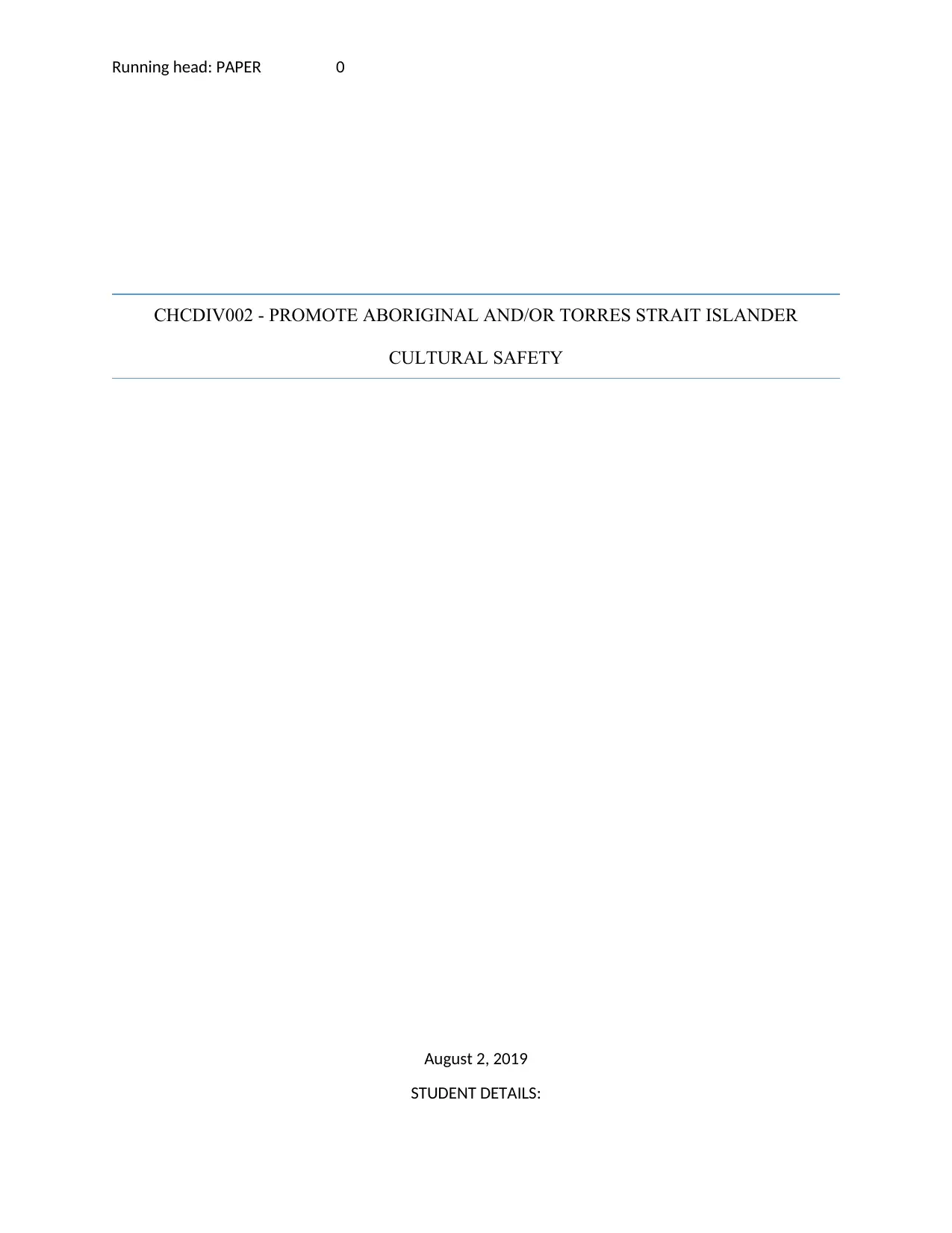
Running head: PAPER 0
CHCDIV002 - PROMOTE ABORIGINAL AND/OR TORRES STRAIT ISLANDER
CULTURAL SAFETY
August 2, 2019
STUDENT DETAILS:
CHCDIV002 - PROMOTE ABORIGINAL AND/OR TORRES STRAIT ISLANDER
CULTURAL SAFETY
August 2, 2019
STUDENT DETAILS:
Paraphrase This Document
Need a fresh take? Get an instant paraphrase of this document with our AI Paraphraser
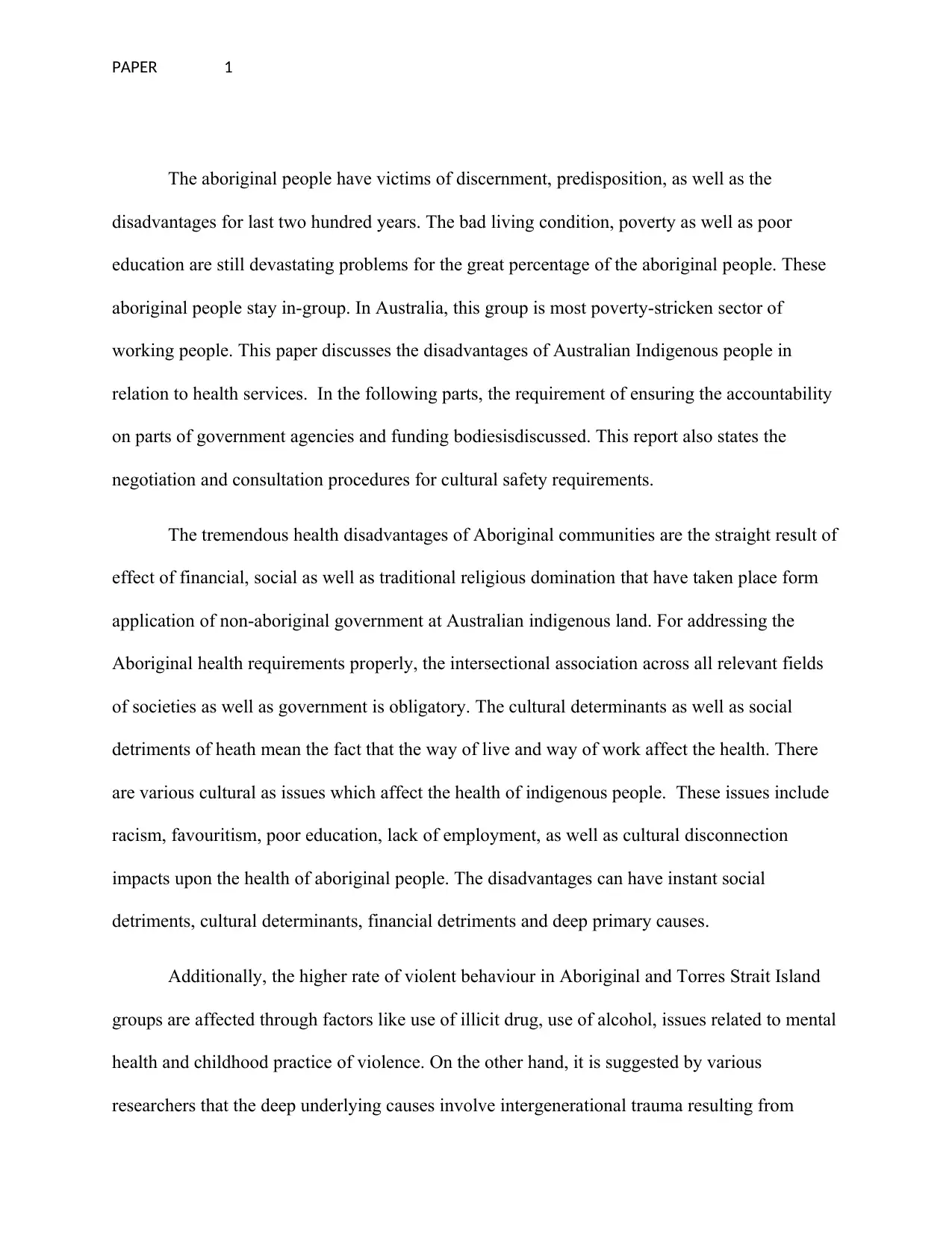
PAPER 1
The aboriginal people have victims of discernment, predisposition, as well as the
disadvantages for last two hundred years. The bad living condition, poverty as well as poor
education are still devastating problems for the great percentage of the aboriginal people. These
aboriginal people stay in-group. In Australia, this group is most poverty-stricken sector of
working people. This paper discusses the disadvantages of Australian Indigenous people in
relation to health services. In the following parts, the requirement of ensuring the accountability
on parts of government agencies and funding bodiesisdiscussed. This report also states the
negotiation and consultation procedures for cultural safety requirements.
The tremendous health disadvantages of Aboriginal communities are the straight result of
effect of financial, social as well as traditional religious domination that have taken place form
application of non-aboriginal government at Australian indigenous land. For addressing the
Aboriginal health requirements properly, the intersectional association across all relevant fields
of societies as well as government is obligatory. The cultural determinants as well as social
detriments of heath mean the fact that the way of live and way of work affect the health. There
are various cultural as issues which affect the health of indigenous people. These issues include
racism, favouritism, poor education, lack of employment, as well as cultural disconnection
impacts upon the health of aboriginal people. The disadvantages can have instant social
detriments, cultural determinants, financial detriments and deep primary causes.
Additionally, the higher rate of violent behaviour in Aboriginal and Torres Strait Island
groups are affected through factors like use of illicit drug, use of alcohol, issues related to mental
health and childhood practice of violence. On the other hand, it is suggested by various
researchers that the deep underlying causes involve intergenerational trauma resulting from
The aboriginal people have victims of discernment, predisposition, as well as the
disadvantages for last two hundred years. The bad living condition, poverty as well as poor
education are still devastating problems for the great percentage of the aboriginal people. These
aboriginal people stay in-group. In Australia, this group is most poverty-stricken sector of
working people. This paper discusses the disadvantages of Australian Indigenous people in
relation to health services. In the following parts, the requirement of ensuring the accountability
on parts of government agencies and funding bodiesisdiscussed. This report also states the
negotiation and consultation procedures for cultural safety requirements.
The tremendous health disadvantages of Aboriginal communities are the straight result of
effect of financial, social as well as traditional religious domination that have taken place form
application of non-aboriginal government at Australian indigenous land. For addressing the
Aboriginal health requirements properly, the intersectional association across all relevant fields
of societies as well as government is obligatory. The cultural determinants as well as social
detriments of heath mean the fact that the way of live and way of work affect the health. There
are various cultural as issues which affect the health of indigenous people. These issues include
racism, favouritism, poor education, lack of employment, as well as cultural disconnection
impacts upon the health of aboriginal people. The disadvantages can have instant social
detriments, cultural determinants, financial detriments and deep primary causes.
Additionally, the higher rate of violent behaviour in Aboriginal and Torres Strait Island
groups are affected through factors like use of illicit drug, use of alcohol, issues related to mental
health and childhood practice of violence. On the other hand, it is suggested by various
researchers that the deep underlying causes involve intergenerational trauma resulting from
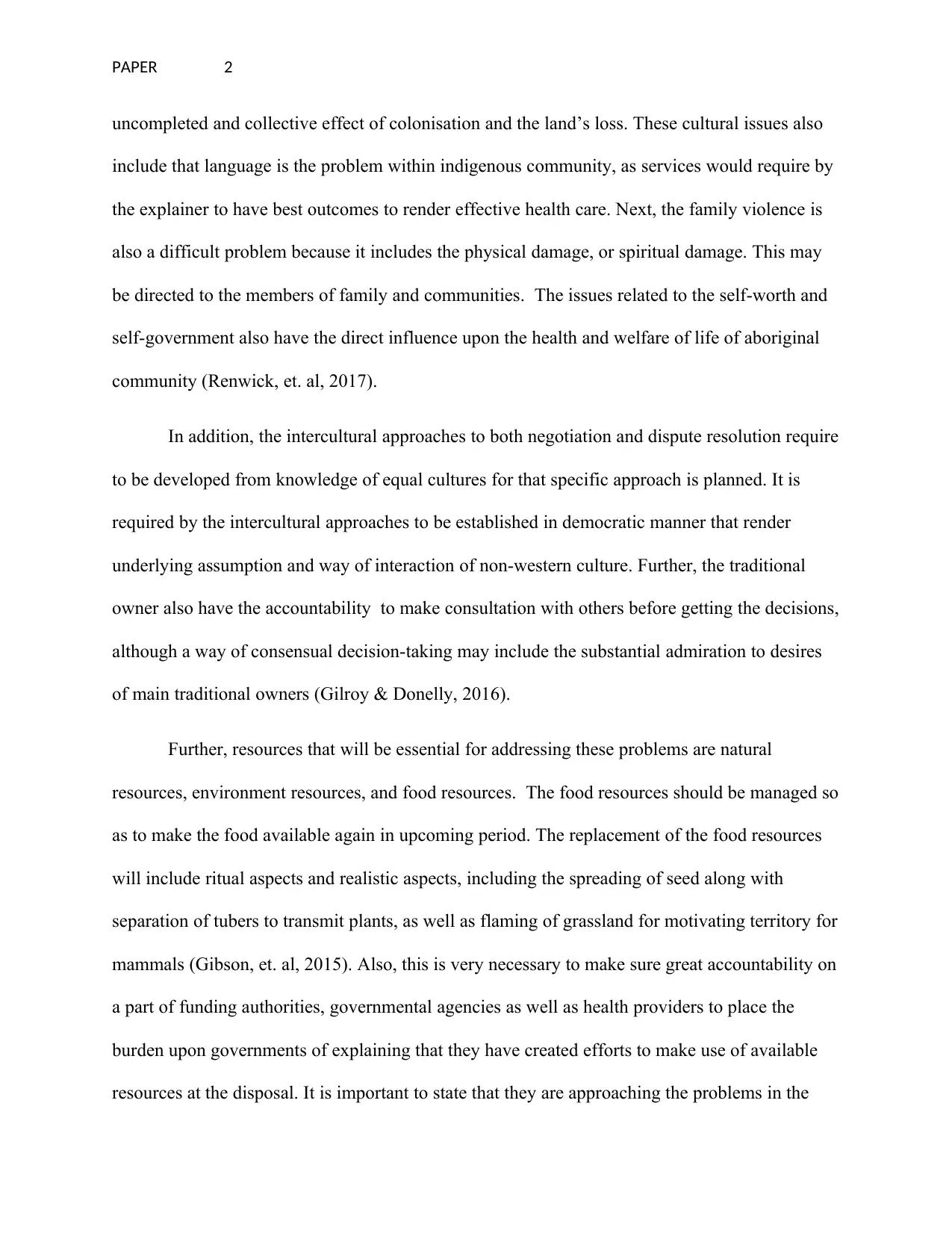
PAPER 2
uncompleted and collective effect of colonisation and the land’s loss. These cultural issues also
include that language is the problem within indigenous community, as services would require by
the explainer to have best outcomes to render effective health care. Next, the family violence is
also a difficult problem because it includes the physical damage, or spiritual damage. This may
be directed to the members of family and communities. The issues related to the self-worth and
self-government also have the direct influence upon the health and welfare of life of aboriginal
community (Renwick, et. al, 2017).
In addition, the intercultural approaches to both negotiation and dispute resolution require
to be developed from knowledge of equal cultures for that specific approach is planned. It is
required by the intercultural approaches to be established in democratic manner that render
underlying assumption and way of interaction of non-western culture. Further, the traditional
owner also have the accountability to make consultation with others before getting the decisions,
although a way of consensual decision-taking may include the substantial admiration to desires
of main traditional owners (Gilroy & Donelly, 2016).
Further, resources that will be essential for addressing these problems are natural
resources, environment resources, and food resources. The food resources should be managed so
as to make the food available again in upcoming period. The replacement of the food resources
will include ritual aspects and realistic aspects, including the spreading of seed along with
separation of tubers to transmit plants, as well as flaming of grassland for motivating territory for
mammals (Gibson, et. al, 2015). Also, this is very necessary to make sure great accountability on
a part of funding authorities, governmental agencies as well as health providers to place the
burden upon governments of explaining that they have created efforts to make use of available
resources at the disposal. It is important to state that they are approaching the problems in the
uncompleted and collective effect of colonisation and the land’s loss. These cultural issues also
include that language is the problem within indigenous community, as services would require by
the explainer to have best outcomes to render effective health care. Next, the family violence is
also a difficult problem because it includes the physical damage, or spiritual damage. This may
be directed to the members of family and communities. The issues related to the self-worth and
self-government also have the direct influence upon the health and welfare of life of aboriginal
community (Renwick, et. al, 2017).
In addition, the intercultural approaches to both negotiation and dispute resolution require
to be developed from knowledge of equal cultures for that specific approach is planned. It is
required by the intercultural approaches to be established in democratic manner that render
underlying assumption and way of interaction of non-western culture. Further, the traditional
owner also have the accountability to make consultation with others before getting the decisions,
although a way of consensual decision-taking may include the substantial admiration to desires
of main traditional owners (Gilroy & Donelly, 2016).
Further, resources that will be essential for addressing these problems are natural
resources, environment resources, and food resources. The food resources should be managed so
as to make the food available again in upcoming period. The replacement of the food resources
will include ritual aspects and realistic aspects, including the spreading of seed along with
separation of tubers to transmit plants, as well as flaming of grassland for motivating territory for
mammals (Gibson, et. al, 2015). Also, this is very necessary to make sure great accountability on
a part of funding authorities, governmental agencies as well as health providers to place the
burden upon governments of explaining that they have created efforts to make use of available
resources at the disposal. It is important to state that they are approaching the problems in the
⊘ This is a preview!⊘
Do you want full access?
Subscribe today to unlock all pages.

Trusted by 1+ million students worldwide
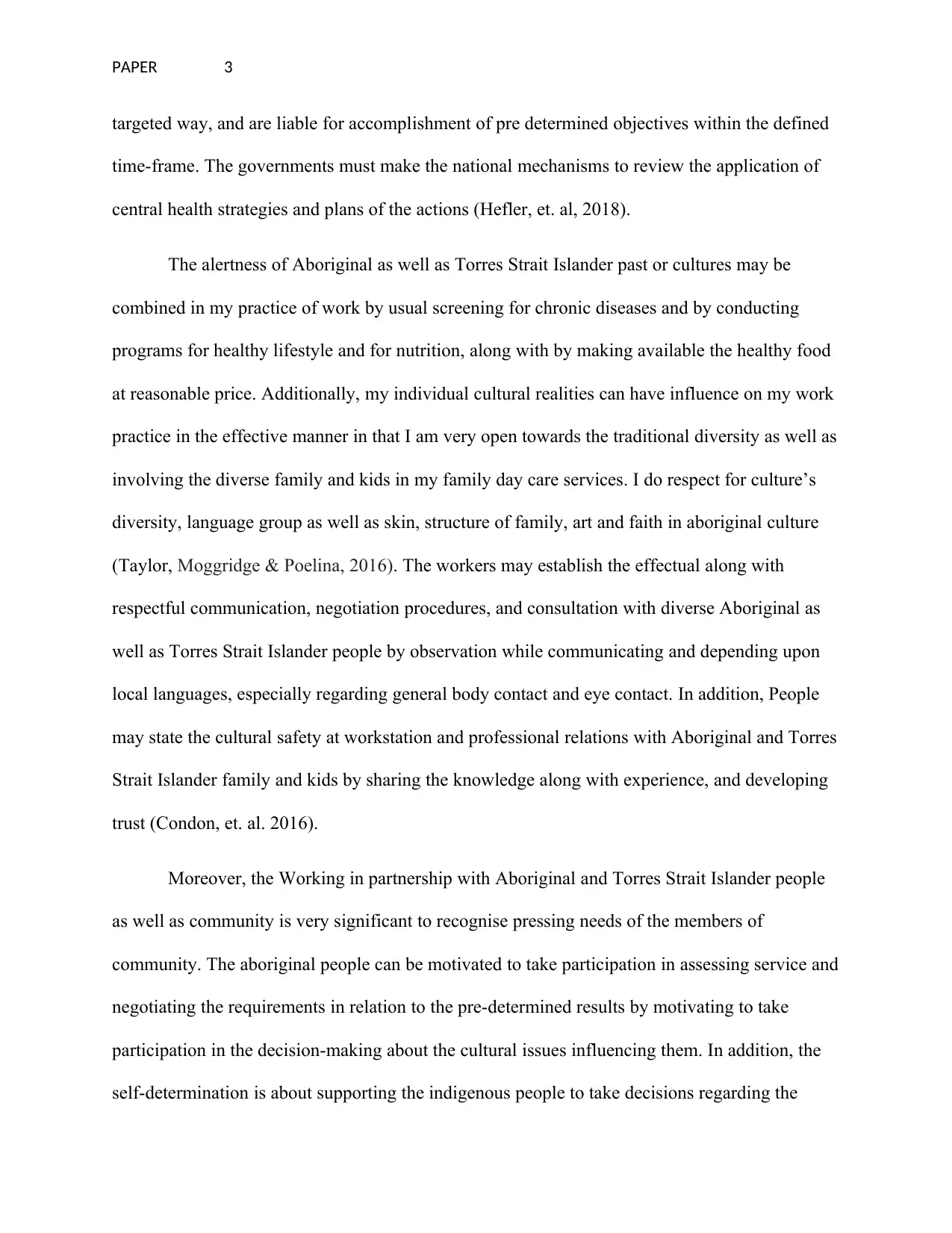
PAPER 3
targeted way, and are liable for accomplishment of pre determined objectives within the defined
time-frame. The governments must make the national mechanisms to review the application of
central health strategies and plans of the actions (Hefler, et. al, 2018).
The alertness of Aboriginal as well as Torres Strait Islander past or cultures may be
combined in my practice of work by usual screening for chronic diseases and by conducting
programs for healthy lifestyle and for nutrition, along with by making available the healthy food
at reasonable price. Additionally, my individual cultural realities can have influence on my work
practice in the effective manner in that I am very open towards the traditional diversity as well as
involving the diverse family and kids in my family day care services. I do respect for culture’s
diversity, language group as well as skin, structure of family, art and faith in aboriginal culture
(Taylor, Moggridge & Poelina, 2016). The workers may establish the effectual along with
respectful communication, negotiation procedures, and consultation with diverse Aboriginal as
well as Torres Strait Islander people by observation while communicating and depending upon
local languages, especially regarding general body contact and eye contact. In addition, People
may state the cultural safety at workstation and professional relations with Aboriginal and Torres
Strait Islander family and kids by sharing the knowledge along with experience, and developing
trust (Condon, et. al. 2016).
Moreover, the Working in partnership with Aboriginal and Torres Strait Islander people
as well as community is very significant to recognise pressing needs of the members of
community. The aboriginal people can be motivated to take participation in assessing service and
negotiating the requirements in relation to the pre-determined results by motivating to take
participation in the decision-making about the cultural issues influencing them. In addition, the
self-determination is about supporting the indigenous people to take decisions regarding the
targeted way, and are liable for accomplishment of pre determined objectives within the defined
time-frame. The governments must make the national mechanisms to review the application of
central health strategies and plans of the actions (Hefler, et. al, 2018).
The alertness of Aboriginal as well as Torres Strait Islander past or cultures may be
combined in my practice of work by usual screening for chronic diseases and by conducting
programs for healthy lifestyle and for nutrition, along with by making available the healthy food
at reasonable price. Additionally, my individual cultural realities can have influence on my work
practice in the effective manner in that I am very open towards the traditional diversity as well as
involving the diverse family and kids in my family day care services. I do respect for culture’s
diversity, language group as well as skin, structure of family, art and faith in aboriginal culture
(Taylor, Moggridge & Poelina, 2016). The workers may establish the effectual along with
respectful communication, negotiation procedures, and consultation with diverse Aboriginal as
well as Torres Strait Islander people by observation while communicating and depending upon
local languages, especially regarding general body contact and eye contact. In addition, People
may state the cultural safety at workstation and professional relations with Aboriginal and Torres
Strait Islander family and kids by sharing the knowledge along with experience, and developing
trust (Condon, et. al. 2016).
Moreover, the Working in partnership with Aboriginal and Torres Strait Islander people
as well as community is very significant to recognise pressing needs of the members of
community. The aboriginal people can be motivated to take participation in assessing service and
negotiating the requirements in relation to the pre-determined results by motivating to take
participation in the decision-making about the cultural issues influencing them. In addition, the
self-determination is about supporting the indigenous people to take decisions regarding the
Paraphrase This Document
Need a fresh take? Get an instant paraphrase of this document with our AI Paraphraser
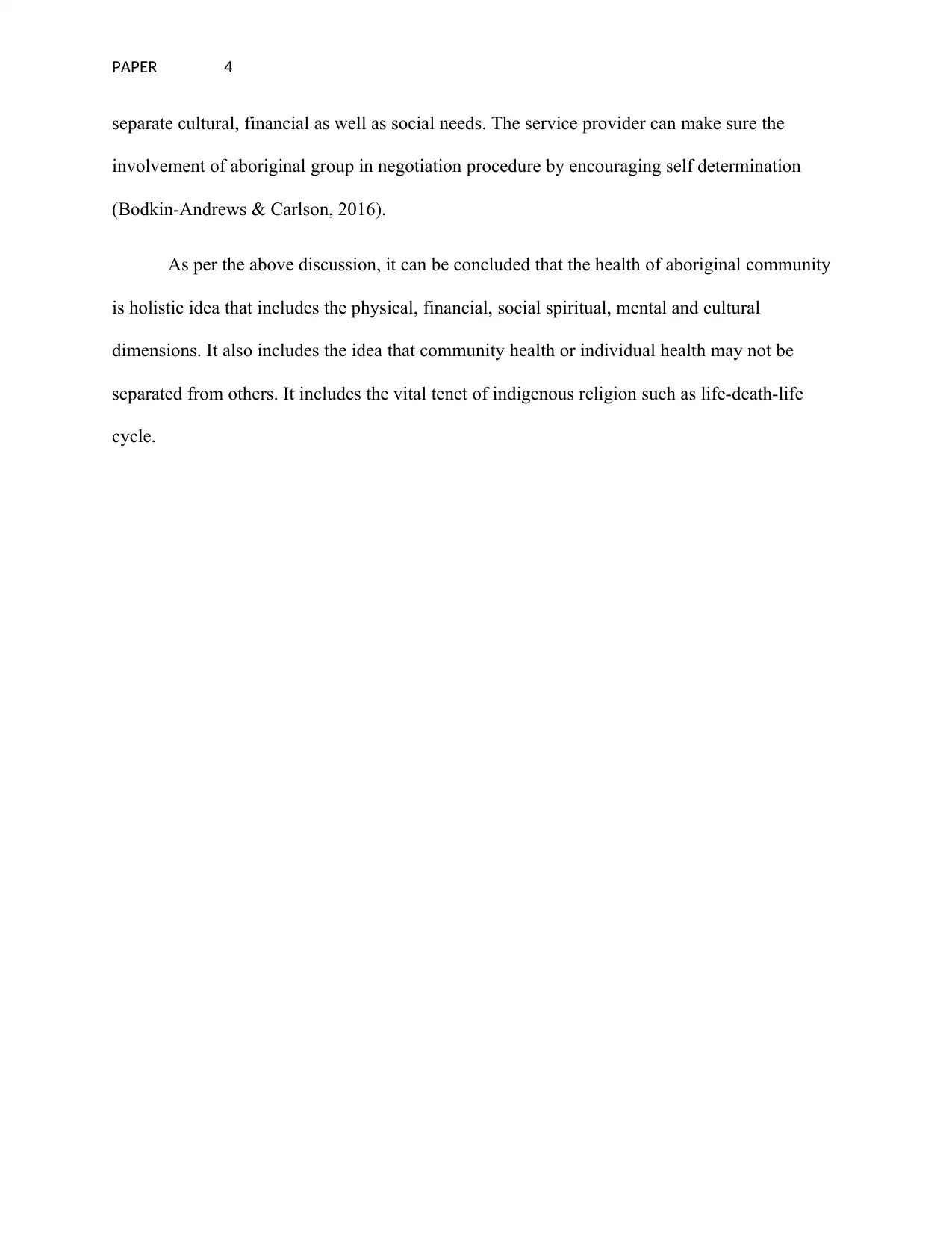
PAPER 4
separate cultural, financial as well as social needs. The service provider can make sure the
involvement of aboriginal group in negotiation procedure by encouraging self determination
(Bodkin-Andrews & Carlson, 2016).
As per the above discussion, it can be concluded that the health of aboriginal community
is holistic idea that includes the physical, financial, social spiritual, mental and cultural
dimensions. It also includes the idea that community health or individual health may not be
separated from others. It includes the vital tenet of indigenous religion such as life-death-life
cycle.
separate cultural, financial as well as social needs. The service provider can make sure the
involvement of aboriginal group in negotiation procedure by encouraging self determination
(Bodkin-Andrews & Carlson, 2016).
As per the above discussion, it can be concluded that the health of aboriginal community
is holistic idea that includes the physical, financial, social spiritual, mental and cultural
dimensions. It also includes the idea that community health or individual health may not be
separated from others. It includes the vital tenet of indigenous religion such as life-death-life
cycle.
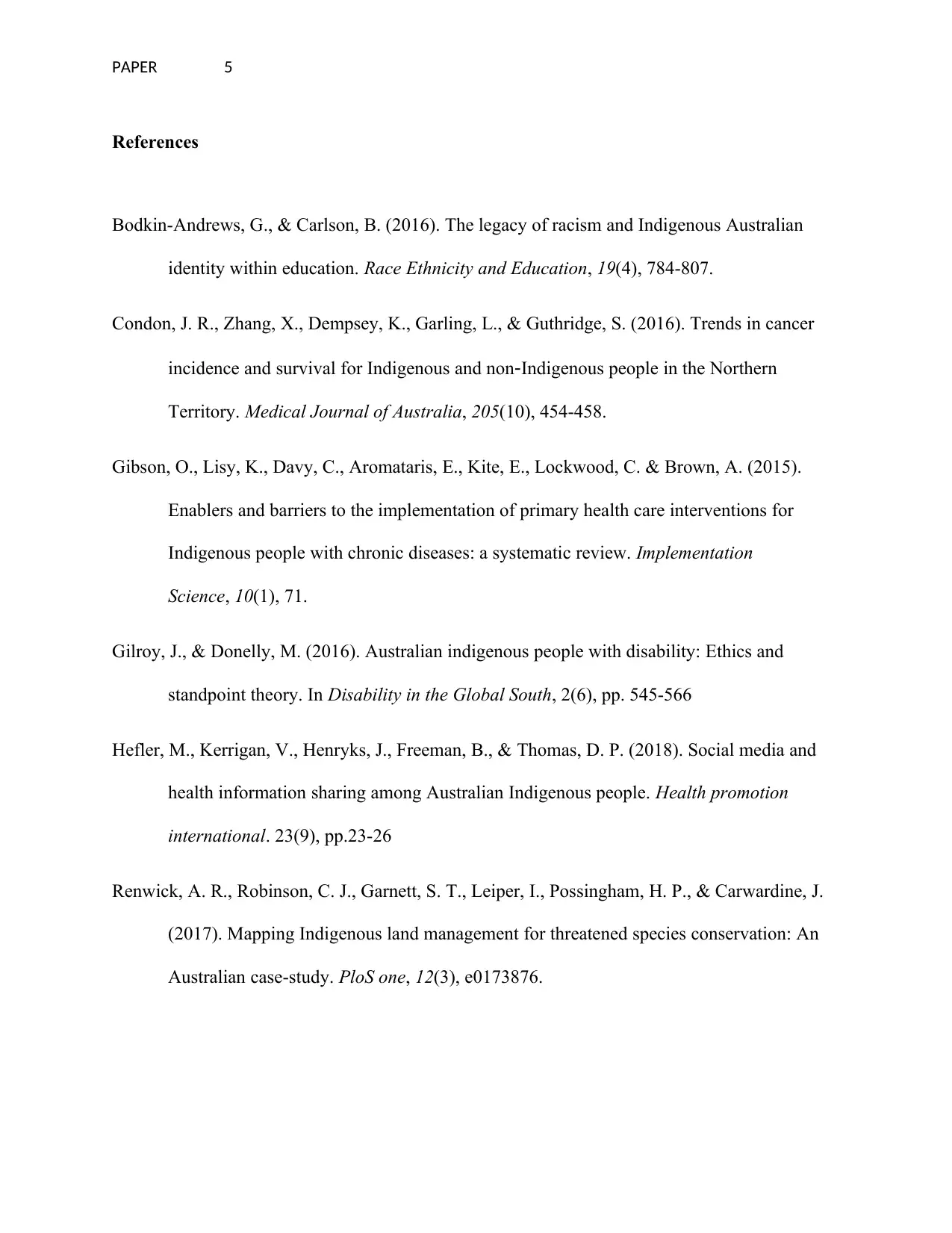
PAPER 5
References
Bodkin-Andrews, G., & Carlson, B. (2016). The legacy of racism and Indigenous Australian
identity within education. Race Ethnicity and Education, 19(4), 784-807.
Condon, J. R., Zhang, X., Dempsey, K., Garling, L., & Guthridge, S. (2016). Trends in cancer
incidence and survival for Indigenous and non‐Indigenous people in the Northern
Territory. Medical Journal of Australia, 205(10), 454-458.
Gibson, O., Lisy, K., Davy, C., Aromataris, E., Kite, E., Lockwood, C. & Brown, A. (2015).
Enablers and barriers to the implementation of primary health care interventions for
Indigenous people with chronic diseases: a systematic review. Implementation
Science, 10(1), 71.
Gilroy, J., & Donelly, M. (2016). Australian indigenous people with disability: Ethics and
standpoint theory. In Disability in the Global South, 2(6), pp. 545-566
Hefler, M., Kerrigan, V., Henryks, J., Freeman, B., & Thomas, D. P. (2018). Social media and
health information sharing among Australian Indigenous people. Health promotion
international. 23(9), pp.23-26
Renwick, A. R., Robinson, C. J., Garnett, S. T., Leiper, I., Possingham, H. P., & Carwardine, J.
(2017). Mapping Indigenous land management for threatened species conservation: An
Australian case-study. PloS one, 12(3), e0173876.
References
Bodkin-Andrews, G., & Carlson, B. (2016). The legacy of racism and Indigenous Australian
identity within education. Race Ethnicity and Education, 19(4), 784-807.
Condon, J. R., Zhang, X., Dempsey, K., Garling, L., & Guthridge, S. (2016). Trends in cancer
incidence and survival for Indigenous and non‐Indigenous people in the Northern
Territory. Medical Journal of Australia, 205(10), 454-458.
Gibson, O., Lisy, K., Davy, C., Aromataris, E., Kite, E., Lockwood, C. & Brown, A. (2015).
Enablers and barriers to the implementation of primary health care interventions for
Indigenous people with chronic diseases: a systematic review. Implementation
Science, 10(1), 71.
Gilroy, J., & Donelly, M. (2016). Australian indigenous people with disability: Ethics and
standpoint theory. In Disability in the Global South, 2(6), pp. 545-566
Hefler, M., Kerrigan, V., Henryks, J., Freeman, B., & Thomas, D. P. (2018). Social media and
health information sharing among Australian Indigenous people. Health promotion
international. 23(9), pp.23-26
Renwick, A. R., Robinson, C. J., Garnett, S. T., Leiper, I., Possingham, H. P., & Carwardine, J.
(2017). Mapping Indigenous land management for threatened species conservation: An
Australian case-study. PloS one, 12(3), e0173876.
⊘ This is a preview!⊘
Do you want full access?
Subscribe today to unlock all pages.

Trusted by 1+ million students worldwide
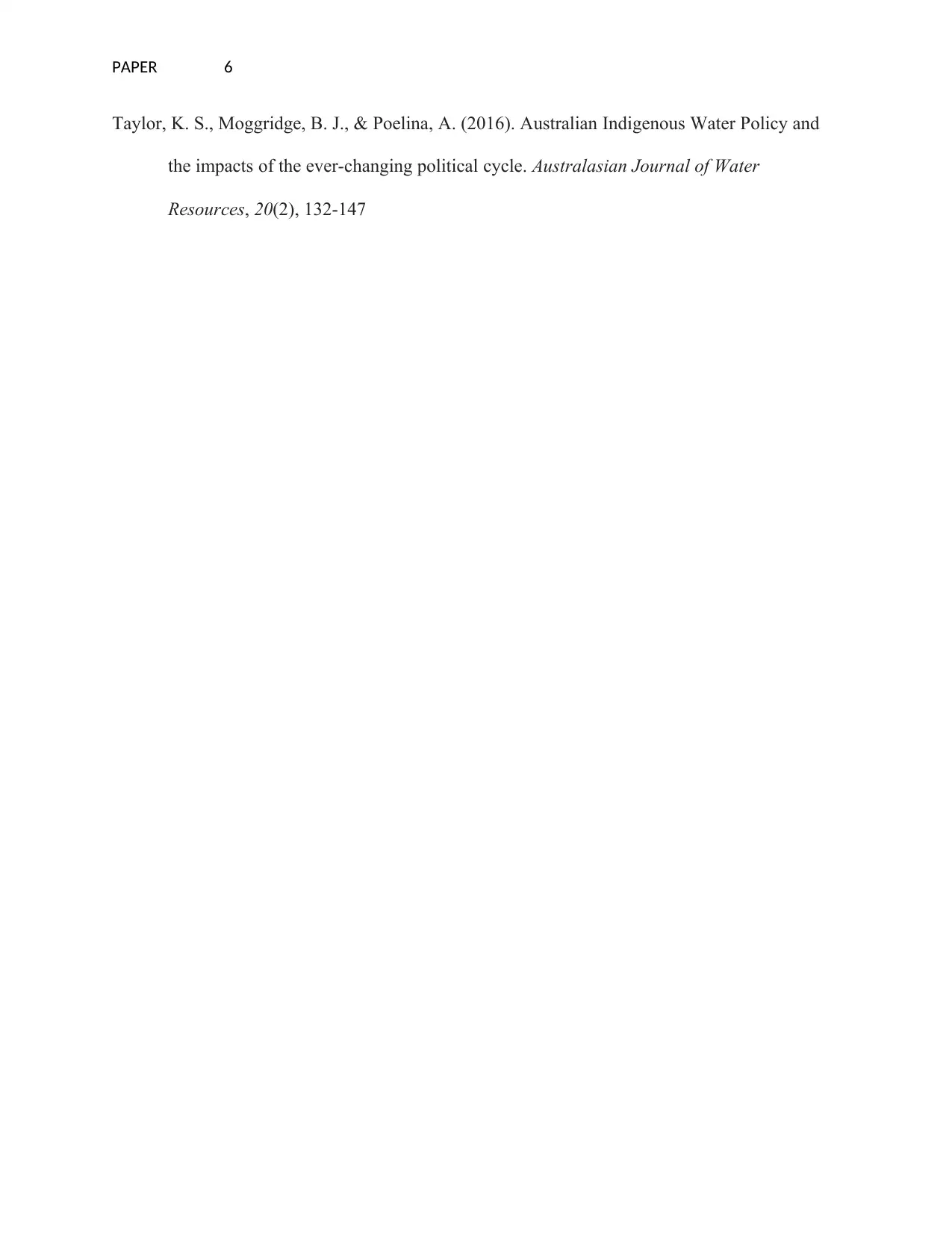
PAPER 6
Taylor, K. S., Moggridge, B. J., & Poelina, A. (2016). Australian Indigenous Water Policy and
the impacts of the ever-changing political cycle. Australasian Journal of Water
Resources, 20(2), 132-147
Taylor, K. S., Moggridge, B. J., & Poelina, A. (2016). Australian Indigenous Water Policy and
the impacts of the ever-changing political cycle. Australasian Journal of Water
Resources, 20(2), 132-147
1 out of 7
Related Documents
Your All-in-One AI-Powered Toolkit for Academic Success.
+13062052269
info@desklib.com
Available 24*7 on WhatsApp / Email
![[object Object]](/_next/static/media/star-bottom.7253800d.svg)
Unlock your academic potential
© 2024 | Zucol Services PVT LTD | All rights reserved.




